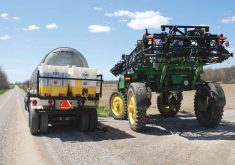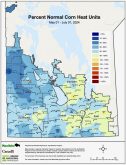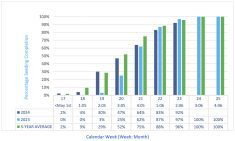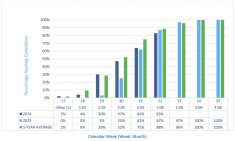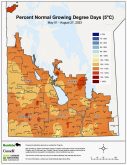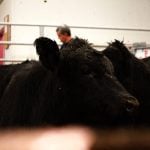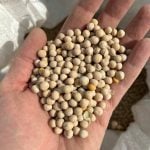Overview
Harvest progress sits at 13 per cent complete across the province, which is on-par with the 5-year average harvest progress. Winter wheat and fall rye harvest is near completion, with 93 per cent of acres harvested. Early yield reports for winter wheat are averaging about 60 bu/acre and 70 bu/acre for fall rye. Harvest continues in spring cereal crops, with barley at 26 per cent complete, oats at 21 per cent complete and spring wheat at 23 per cent complete. Overall, cereal crops remain in fair to mostly good condition.
Corn is mostly in the R4 to R5 growth stages. Canola is mostly in the pod fill stage, with some fields starting to turn with desiccation and swathing continuing. Field pea harvest continues, with approximately 69 per cent of acres harvested. Soybean fields are mostly in the R6 to R7 growth stages with reports in the central region of soybean showing stress symptoms due to lack of moisture. Premature ripening has occurred on these fields.
Read Also

What is perfect Christmas weather?
What is ‘perfect’ Christmas weather on the Prairies? Here’s where you should head this holiday, according to historical weather data.
Producers are encouraged to scout their fields for weeds which have escaped control. This is an important part of integrated pest management. Waterhemp has been found in the Central and Eastern regions and producers should seek identification of any unusual pigweeds in their field.
Cereals
Harvest of winter wheat and fall rye continued with about 93 per cent of acres combined. Yield reports for winter wheat range from 50 to 65 bu/acre and fall rye yields in the 60 to 90 bu/acre range.
Spring cereal crops are mostly in the hard dough stage, with pre-harvest desiccation and swathing continuing. All regions are reporting the start of harvest for spring cereals.
The spring wheat quality is rated mostly fair to good.
Corn fields ranged from the R4 to the R5 stage
Oilseeds
The majority of the canola crop is in the late pod fill stage, with colour change noted on earlier seeded canola. Swathing and pre-harvest applications have started on the earliest seeded fields.
Sunflower fields were in the R7 (back of the head starting to turn pale yellow) to the R8 (back of the head yellow but bracts remain green) growth stages.
The majority of sunflower fields ranged from R6 (flowering completed and ray flowers drying down) to Sunflower fields R7 (back of the head starting to turn pale yellow) growth stages.
Flax crop growth stage ranged from late stage 10 (green capsule) to mid stage 11 (brown capsule) with lots of variability being noted in fields.
Pulses and soybeans
Field pea harvest continues in most parts of the province, with approximately 69 per cent of harvest completed. Early yield reports in the Southwest and Central regions are in the 45 to 55 bu/acre range and 60 to 70 bu/ac range in the Northwest region.The majority of the crop is in good condition.
Soybeans range from the R6 to R7 stage. Rains over the past week will help with pod fill. Overall crop condition remains good.
There are reports of dry beans being undercut or desiccated in the Central region, and the start of harvest is anticipated to occur this week.
Forages and livestock
Forages
Majority of dairy producers in the Eastern region completed third cut last week. Yields are being reported as much better than second cut. Beef producers have largely completed first cut and greenfeed harvest. Roughly half of beef producers have completed second cut. Hay yields remain highly variable and are dependent on moisture conditions.
Corn silage harvest is expected to begin in the near future.
Recent rain has helped pastures and second cut as things start to green up again and hay crops grow.
Grasshoppers continue to be problematic in certain hot spots around the region.
Cereal silage harvest wrapping up with yields down ranging from 5-8 wet tons/ac. Most hay harvest has
been completed with the occasional second cut or native hay field being finished up. Hay supplies vary but some producers will be short and securing additional feed.
Livestock
Grass conditions on pasture are deteriorating and highly dependent on moisture levels, grazing management strategy, and soil type. Some producers are supplementing hay on pasture to ensure nutrient requirements of cattle are being met and to take pressure off the grass.
Some community pastures will be sending cattle home earlier due to dry conditions throughout the growing season.
Some producers are beginning to move cattle onto fenced hayfields to graze available regrowth. Water levels in dugouts are very low. This is of particular concern on pastures located in areas that have consistently missed out on rain. Water supplies range from low to adequate in the Northwest region.
Sourcing straw is a concern due to cereals being short and grain producers not being as willing to drop straw.
Regional comments
Southwest
Producers returned to the fields later in the week as fields dried. During the week harvest preparation occured with pre-harvest application continuing and some swathing happening. Strong winds during the week played havoc with some crops especially ripe oats and some wheat varieties that were starting to shell. Harvest began towards the end of the week with producers finishing up on most of the peas and starting cereal harvest. Several producers starting on wheat were able to take advantage of swathed fields as they were dry or close to dry over the weekend. Producers are commenting on how fast some of the crops are drying down and speeding up harvest. Crops continue to mature and harvest will be general this week as long as weather cooperates. In general, crops look average with average yields and good quality.
Fall rye and winter wheat harvest is pretty much complete in most areas in the Southwest and yields look to be average with good quality. Producers are starting to plan on winter cereals for 2024.
Most of the pea harvest is complete with just some of the later fields left to harvest. Overall the crop stood well and was easy to harvest. Yield looks to be average with good quality around 45 to 50 bu/ac.
Wheat harvest of early seeded fields continued later in the week and weekend. Most cereal crops fields have had pre-harvest done. Yields look to be average to slightly above average with good test weight and protein on the early harvested fields.
Barley harvest continued towards the end of the week and quality and yield are average.
Oat harvest continued towards the end of the week strong winds have been shelling some of the standing crop. Yields look to average and quality might be a factor as we may have some light weight oats in some areas.
Most of the canola crop is starting to turn and is in the seed color change. No major insect or disease issues showing up. Soybeans are at R6 stage. Recent rain has helped with seedfill and with the later seeded beans. Some late weed growth in areas where the stands are thin especially volunteer canola have been reported. Sunflowers in the R6 stage. Flax crops are in the brown boll fill stage to seed color stage.
Most corn is in the R4 stage. Crops have managed the dry conditions well and good height is reported in many fields.
Northwest
A mixed week of weather across the region. Hot days with temperatures in the 30’s followed by cool, rainy weather was in the mix. Highest temperature was in Swan River at 32 C, and Ruthenia overnight low was 3.9 C. Scattered showers and strong winds for part of the week made some challenges for pre-harvest applications and desiccation. Smoky conditions also were present. Precipitation was more on the west side of the region while the eastern side received minimal rain. Birch River station received the most precipitation (18.4mm), while Amaranth received lowest (1.4mm).
Fall Rye and winter wheat harvest is 95 per cent complete. Yields vary widely and dependent on early season rains.
Spring cereals are mostly in the hard dough stages to mature, with the odd field slightly behind. Pre-harvest applications were ongoing and moving towards complete. Harvest has started in the western side of the region and more advanced towards Dauphin area. Harvest progress is approximately 5 per cent across the region. Initial reports have been average to above average so far.
Most of the canola across the region is podded and maturing. Approximately 5 per cent of the canola remains flowering but should wrap up shortly. Reports of small pods in upper canopy with reduced seed set and may affect yield in some fields. Some sunscald is evident with recent high temperatures. Aster yellow symptoms are very noticeable in some fields. Flea beetle pressure has been heavy in the last week and tops of plants are found covered in flea beetles. Lygus and some Bertha Armyworm has been reported in canola. There has been a start to desiccation or swathing as some of the earliest seeded canola fields have reached the appropriate stage.
Field Pea harvest is continuing as crops reach maturity, with a pause last week due to rain. Desiccation continues in fields that have reached the appropriate stages and should be close to complete. Field pea harvest is approximately 50 per cent complete across the region. Yield ranges are mostly dependent on precipitation through the season. Fields with little precipitation ranged from 40 to 45 bu/ac while better fields ranged from 60 to 70 bu/ac.
Soybeans are mostly at the R6 stage and advancing towards R7. A few fields that were stressed through the season are in the more advanced stage. Recent precipitation should help with seed fill.
Central
It was a dry week in the Central Region. Elie received the most rainfall at 3.1mm, with many locations receiving no rain at all including Carman, Manitou, Morden, and Treherne. Rain would still be beneficial for corn, soybean, sunflowers, pasture, and edible beans, but as harvest approaches, the benefit diminishes.
Winter wheat and fall rye harvest is complete. Fall rye yields have varied greatly depending on how much rainfall the crop received this year, with most yields in the region of 60 to 90 bu/ac. However, some fall rye yields are as low as 30 bu/ac. Winter wheat yields averaged 60 bu/ac.
Harvest of spring cereals are underway, with spring wheat harvest sitting at around 45 per cent, barley 60 per cent and oats 45 per cent. Cereals are either at the hard dough stage or full maturity. Spring wheat yields are highly variable, depending mostly on how much rainfall the crop received during the growing season. Most spring wheat yields have been in the region of 35 to 65 bu/ac, but yields have ranged from as low as 16 bu/ac to 80 bu/ac only a few miles away. Oats have been yielding 80 to130 bu/ac. Barley yielding between 70 and 100 bu/ac.
Corn is at R3 (milk), and R4 (Dough) stages, with the most advanced fields at early R5 (dent). Most fields would benefit from rainfall, with some having observable wilting symptoms.
Field pea harvest is continuing, with fields now at R7 (full maturity). Approximately 75 per cent of the pea crop has been harvested, with most yields in the region of 45 to 60 bu/ac. However, on some of the driest fields, yields are as low as 30 bu/ac, and in the most favorable fields, as high as 70 bu/ac.
Canola is undergoing pod fill and dry down, with most canola now in the range of 30 to 70 per cent seed colour change. Many fields have been swathed, with a very small number, approximately 2 per cent, already harvested. Early harvested canola is showing yields between 25 and 50 bu/ac. Flax is approaching harvest, with most fields now between late stage 10 and stage 11 (brown capsule). The earliest flax fields may begin to be harvested next week. Sunflowers are mostly between R7 and R8. Dry bean harvest has started with fields being undercut and the first fields being harvested.
Many crops have or will receive a pre-harvest herbicide application, in part to help combat the high levels of weeds present in fields, especially pigweeds, kochia and lambs quarters. Producers are scouting their fields for waterhemp and/or Palmer amaranth, and for the most part are investigating any unusual weeds, especially those that have escaped control measures.
Eastern
Rainfall accumulations ranged from trace to less than 10 mm falling as drizzle, showers or moderate rainstorms. A smaller portion of this rain fell last Tuesday with the greatest amounts in the northern districts. Most of the rainfall came on Monday of this week with central and southern districts seeing the greatest amounts. Daytime temperatures started the reporting period at seasonal levels and warmed to slightly above seasonal over the weekend. Nighttime temperatures were seasonal all week but dropped to below seasonal over the weekend. Producers look toward making significant progress on spring cereal harvest and accompanying field work this week if the weather allows.
Harvesting of winter wheat was completed last week with fall rye about 70 per cent done and expected to be completed shortly. Overall, average yield on winter wheat improved to about 75 bu/acre. Fall rye yields ranged from about 45 to 90 bu/acre and will likely average out at around 75 bu/acre.
Spring cereal crops ranged from the hard dough stage to harvest ready. Good progress was made last week with about 20 per cent of spring wheat complete along with about 10 per cent of oats and barley. Average yield on spring wheat has been better than expected at around 65 bu/acre with 13.5 per cent or higher protein levels and grading #1 or #2. Oat yields reported thus far have ranged from 50 to 120 bu/acre. Application of pre-harvest herbicides and swathing was ongoing with about 60 per cent of acres complete. Some field work on harvested cereal fields have been done as there are a few growers who have completed their cereal harvest.
Corn fields ranged from the late R3 (milk) through to the R4 (dough) and even early R5 (dent) growth stages dependent on seeding date and variety being grown. The majority of the crop remained in good to excellent condition but some fields in lower rainfall areas slipped into fair condition demonstrating overall wilting, lower leaves firing off and cob tip dieback.
Sunflower fields were in the R7 (back of the head starting to turn pale yellow) or the R8 (back of the head yellow but bracts remain green) growth stages with many fields being a mix of both. The crop remained in good to excellent condition.
Canola crops in the region ranged from late pod fill with straw and pod colour change to swathing/pre-harvest application ready to harvest ready. Swathing and pre-harvest herbicide applications had started last week and are expected to become more general this week. Some very early seeded fields that had been swathed or sprayed last week might be harvested by the end of this week or early next week if the weather allows. Overall crop condition ranged from fair to mostly good. Insect scouting continued but there were fewer concerns and fewer insecticide applications as the crop advanced out of susceptible stages.
Flax crop growth stages ranged from late stage 10 (green capsule) to mid stage 11 (brown capsule) with lots of variability being noted in fields. The crop was in fair to mostly good condition.
Soybeans were in the mid to late R6 (full seed) growth stage and many fields were demonstrating some level of leaf colour change and leaf drop. As well, some fields seeded to earlier maturing varieties had moved to the R7 growth stage with greater amounts of leaf colour change and leaf drop. Overall crop condition remained good on most fields. The presence of white mould, which had been noted in the previous week, was reported with greater frequency this week and especially so in fields with rank, lush plant growth and high yield potential.
Field pea harvest was about 70 per cent complete. Yields were higher than expected given the periodic dry conditions experienced earlier on in the growing season and averaged out at around 70 bu/acre so far with good quality. Rapid progress and harvest completion are expected this week if the weather allows.
Interlake
Precipitation continues to be variable with scattered thundershowers resulting in minimal amounts of rainfall. The south Interlake region received about 5mm of rain past week, with temperature ranging from 24.0 to 16.5. The northern part of the Interlake received a significant amount of soil moisture though most crops are past the stage of requiring precipitation. Corn and sunflower are the only crops still actively growing. Rain showers are delaying some producers from swathing their cereals. Harvest continues however there have been some minimal delays following recent showers in the Interlake region. In general, harvest progress varies across the region depending on moisture, variety and seeding dates.
Winter wheat and fall rye harvest is complete in the region with yield reports in the 50-70 bu/ac and 60 -100 bu/ac respectively. Spring wheat harvest continues and process is about 15 per cent with yield reports ranging from 50 to 70 bu/ac. Spring wheat yields have been variable and dependent on summer rainfall.
Oat harvest process is about 25 per cent done and barley is about 40-50 per cent with yield estimates of 120 bu/ac and 80 bu/ac respectively. Barley swathing just started in Teulon area. Harvest should be widespread by next week if weather conditions becomes favorable.
Soybeans have advanced to the R6-R7 but varies across the Interlake region; some have started turn yellow and are actively dropping leaves.
Pea harvest process continues and is about 60 per cent done with yield reports of about 65 bu/ac.
The majority of the canola is close to swathing or desiccating and looks excellent. Late seeded or reseeded canola is podding and is looking good in fields that have received adequate rainfall.




